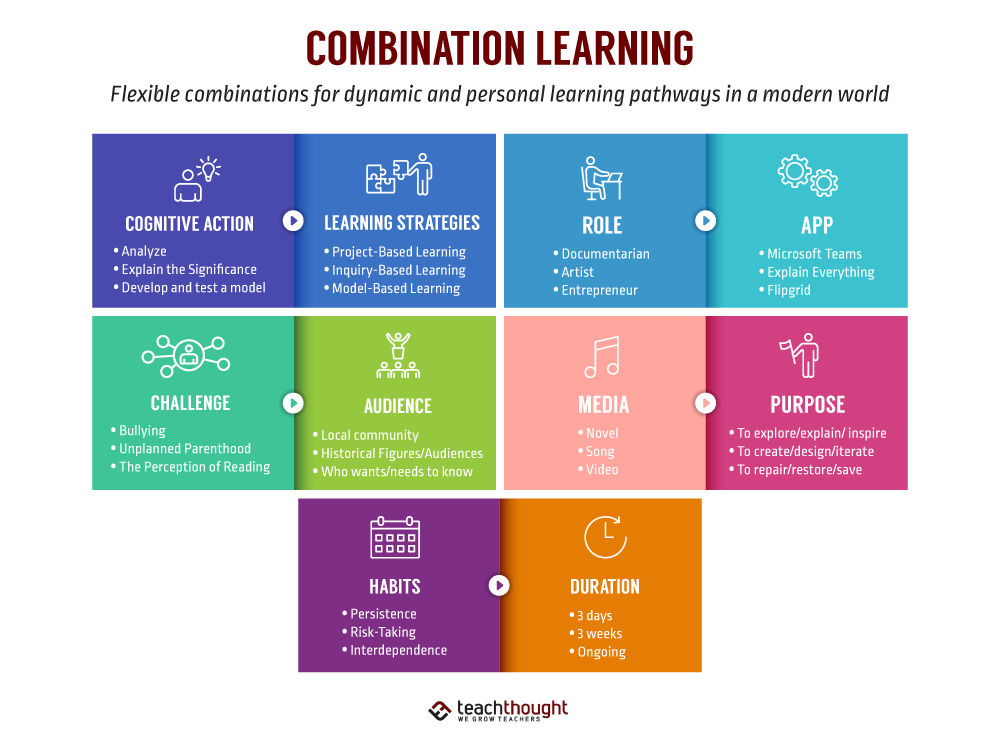
What Is Combination Learning?
by Terry Heick
Combination Learning is a new teaching and learning strategy for the 21st-century. The definition of Combination Learning is learning through the flexible combination of two or more learning components.
This is a new learning strategy developed by TeachThought that responds to the endless possibilities in modern learning environments. It is purposefully flexible, and adaptable to a variety of content areas, grade levels, and available local technology.
The Big Idea
The big idea of combination learning is shifting the focus from content to the process of learning.
Combination Learning allows teachers and students to work together to ‘mash’ bits and pieces of learning to design entirely unique and personalized learning scenarios. The result is a flexible, self-directed learning environment where the teacher acts as facilitator and mentor, and the student is at the center of–and entirely accountable for–their own progress and performance.
It can be as simple or complex as the circumstances call for. It can be standards-based or open-ended; technology-based or based on in-person human interaction; project-based, game-based, rigorous, supportive, etc. In that way it is more of a shell or template for teachers and students to fill as necessary.
Student Directions
Pick and choose one or more of the following ‘ingredients’ or ‘pieces’ to use and/or combine to create a learning experience that’s meaningful to you, and results in something interesting, playful, and uniquely you.
Try to start with yourself: Who are you, what are you a part of, and what does that membership suggest that you understand and do?
Remember, these are just examples. There are dozens for every category.
7 Examples Of Combination Learning
1. Combination: Model-Based Learning + Netflix + the obsolescence of against technology
Paraphrased: Use model-based learning to analyze what makes Netflix popular, and use it to solve the problem of obsolescence of aging technology in local communities
2. Combination: Questions To Guide Inquiry-Based Learning + Use of sampling and allusion in modern hip-hop + Analyse + Essay or 5 minute YouTube documentary
Paraphrased: Use inquiry-based learning to explore and analyze the concept of hip-hop artists sampling classic music, then package your ideas in an essay or short documentary
3. Combination: The Sandbox + Peer Instruction + The Water Cycle
Paraphrased: Use the learning simulation ‘The Sandbox’ to explain the Water Cycle to a peer in some way that’s ‘new’ to their understanding. (Again, this could also be a different app, a video, a short essay, an infographic, etc.)
4. Combination: Separate Causes & Effects + Immigration + podcast + Self-created Rubric
Paraphrased: Separate the causes and effects of immigration through research, then create a presentation to your local student body or other more relevant audience. Self-assess podcast (it can be unpublished) through self-created rubric
5. Combination: Twitter + Spotify + Design
Paraphrased: Design an app that combines the function of twitter and Spotify to create something new
6. Combination: Right triangles + Bridge Constructor + Structural Analysis + Flipgrid (see How To Use Flipgrid: A Guide For Teachers)
Paraphrased: Study and use right triangles to design bridges using the app ‘Bridge Constructor’ (any similar app would work), then complete a structural analysis of the results in brief video (using Flipgrid, for example).
7. Combination: Project-Based Learning + Local Challenges + Local Entrepreneurs
Design a 6 week project that addresses some self-selected local challenge through collaboration with local experts or entrepreneurs—or groups at an elderly home or related organization, for that matter.
Text-Version Of Graphic
Below are some examples of these ingredients/pieces of the learning process. Note, though Combination Learning can be as scripted or open-ended as circumstances demand, lesson templates like Hunter’s lesson plan format are probably more ideal if you have a standard, objective, target, assessment form, grouping goal, literacy strategy, and other critical parts of the learning process are ‘non-negotiable.’
Need to Know Sources (reasons to learn)
Citizenship; self-knowledge; stuff you’re curious about; the kinds of things other people study; family or community needs; academic standards; where you feel incomplete or underdeveloped
Audience
Who wants or needs to know? This ideally would start outside the classroom.
Roles (point of views to think/act from)
Historian, Craftsman, Farmer, Documentarian, Scientist, Designer, Engineer, Writer, Photographer, Artist, Journalist, Teacher, Curator, CEO, Human Being, Activist, Botanist, Conservationist, Hippie, Coder, Hacker, Musician, Publicist, Entrepreneur, App Developer
Purposes (Why you’re acting/creating/designing)
To explore/explain/inspire
To persuade/inform/entertain
To create/design/iterate
To repair/restore/save
Media Channels (information sources)
YouTube, books, poems, movies, stories, songs, videos, encyclopedias, posters, conversations, nature, video games, etc.
Apps (that research, simulate, record, create, publish, curate, connect, etc.)
Quora, Wikipedia, reddit, Explain Everything, etc.
Cognitive Actions (strategies for thinking)
Identify, Analyze, Evaluate, Create; Explain the significance, Critique, Design, Connect, Explain, Narrate, Separate cause and effect, Compare and contrast, Form and revise questions based on learning, etc.
Learning Strategies (strategies for planning learning)
Model-Based Learning; Inquiry-Based Learning; Play; meLearning; Self-Directed Learning; Reflect & Respond; Project-Based Learning (4 Ps); Peer Instruction; Scenario-Based Learning
Questions
Essential questions; self-created questions and matters of inquiry; questions posed by community members; challenges rephrased as questions
Problems/Challenges
Bullying, Social Media Abuse, Distracted Driving, Drinking and Driving, Unplanned Parenthood, Literacy, Bad Work, etc.
Collaborators
Local business, universities, peers, families, neighbors, entrepreneurs, etc.
Image attribution clkr.com; The Definition Of Combination Learning